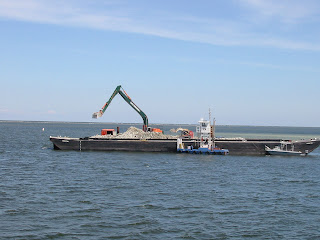
If you're weary of bad news involving government programs that don't work, take some heart in the recent experiment at restoring oyster habitat in North Carolina's Pamlico Sound. By all accounts, it's working.
That's the assessment of the National Oceanic and Atmospheric Administration, the N.C. Division of Marine Fisheries, the nonprofit N.C. Coastal Federation, researchers at N.C. State University, the North Carolina Sea Grant program and researchers at UNC Wilmington.
Last year, these groups collaborated on an effort to restore oyster reefs in one of the first habitat restoration projects under the federal Recovery Act program. NOAA granted $5 million to the groups to pay for a collaborative effort that would physically rebuild the reefs in the sound that once was an amazingly abundant source of oysters. In the 19th century, there were so many oyster reefs that they were regarded as a menace to navigation. But in late 20th century the oysters were in significant decline thanks in part to overharvesting, poor water quality and other factors.
For years both the Coastal Federation and the Division of Marine Fisheries have worked at smaller projects to rebuild the reefs and to improve water quality so the oysters would have a chance to make a comeback. It's important because oysters not only provide food, they also act as aquatic filters capable of filtering something like 50 gallons of water per day.
In North Carolina, planners identified two sites to begin: A 22 acre site near Stumpy Point known as Crab Hole, not far from other Marine Fisheries efforts, and a 25-acre site within sight of the Cape Hatteras Lighthouse about three miles west of Hatteras, called Clam Shoal. It's a fascinating story that involves trucking basketball-sized and football-sized limestone marl from a quarry in New Bern to a dock in Belhaven. There the stone is loaded aboard a barge, where Stevens Towing Co. tugboats push them out to the site in Pamlico Sound to a mooring near shallower water. From there, a small Stevens tug picks up the barge of marl and tows it to Clam Shoal. There a huge loader and a skid steer loader on another barge alongside pick up the stone and place it on the sound floor in cone-shaped mounds about 75 feet apart. Within a day, these structures attract fish; within months, they'll be covered with oyster spat. In a year or so, they'll be covered by healthy oysters in a bivalve sanctuary that won't be open to oyster harvesting, but will serve as a sort of nursery to boost oyster growth throughout the sound. A group of environmentalists, news writers and government officials watched the operation Monday in a 15-knot northwest breeze as the operation neared its completion.
Marine Fisheries officials say after many years of declines, oyster harvests have begun to increase, and inspections of new oyster reefs completed last fall show heavy concentrations of oysters growing on the new structures. The $5 million grant, which has provided something like 140 jobs at the quarry, the trucking company, the towing company and among others working on the project, runs out next month. The coalition of groups are hoping to find another source of funding, such as the N.C. Clean Water Management Trust Fund, to continue the progress toward remaking the oyster beds of Pamlico Sound. For oyster lovers, it would be an easy call, even in a difficult economic recovery: jobs, environmental restoration and protection and an edible delicacy like no other.





No comments:
Post a Comment